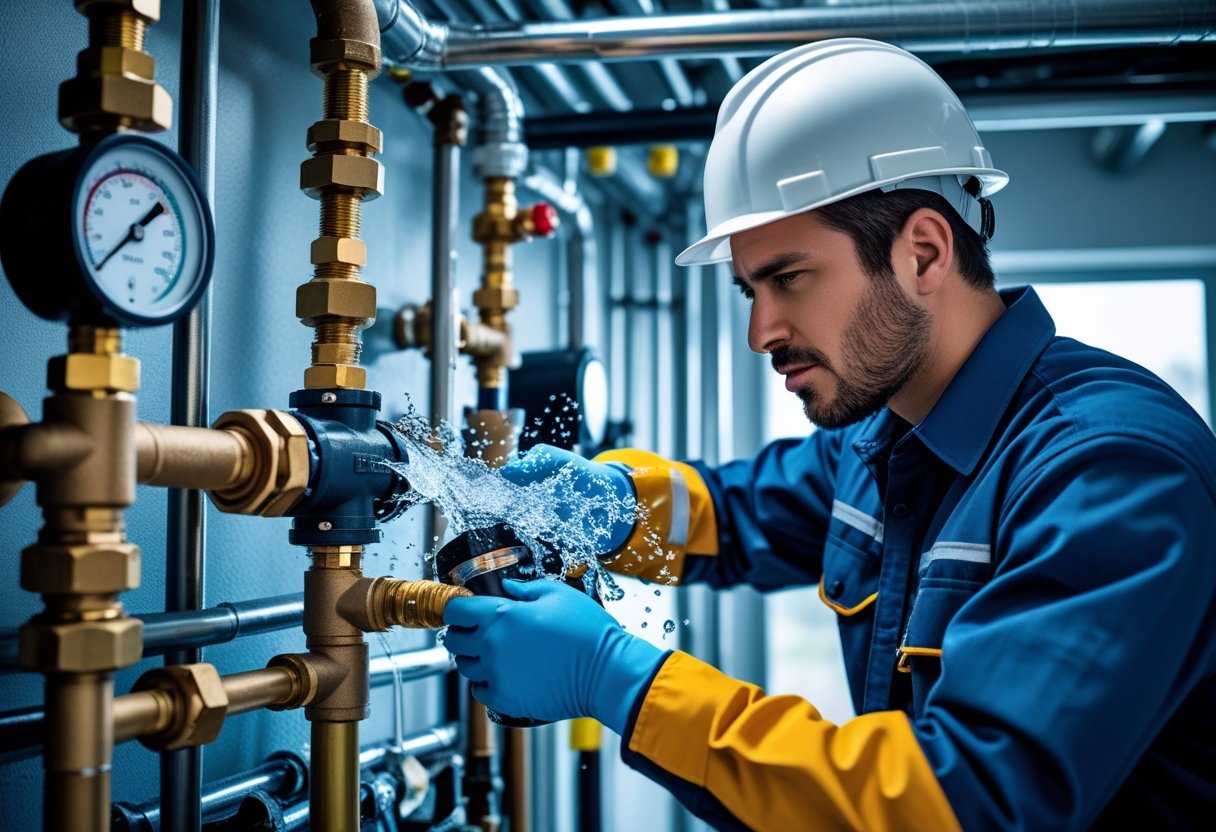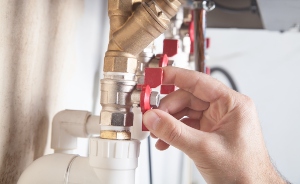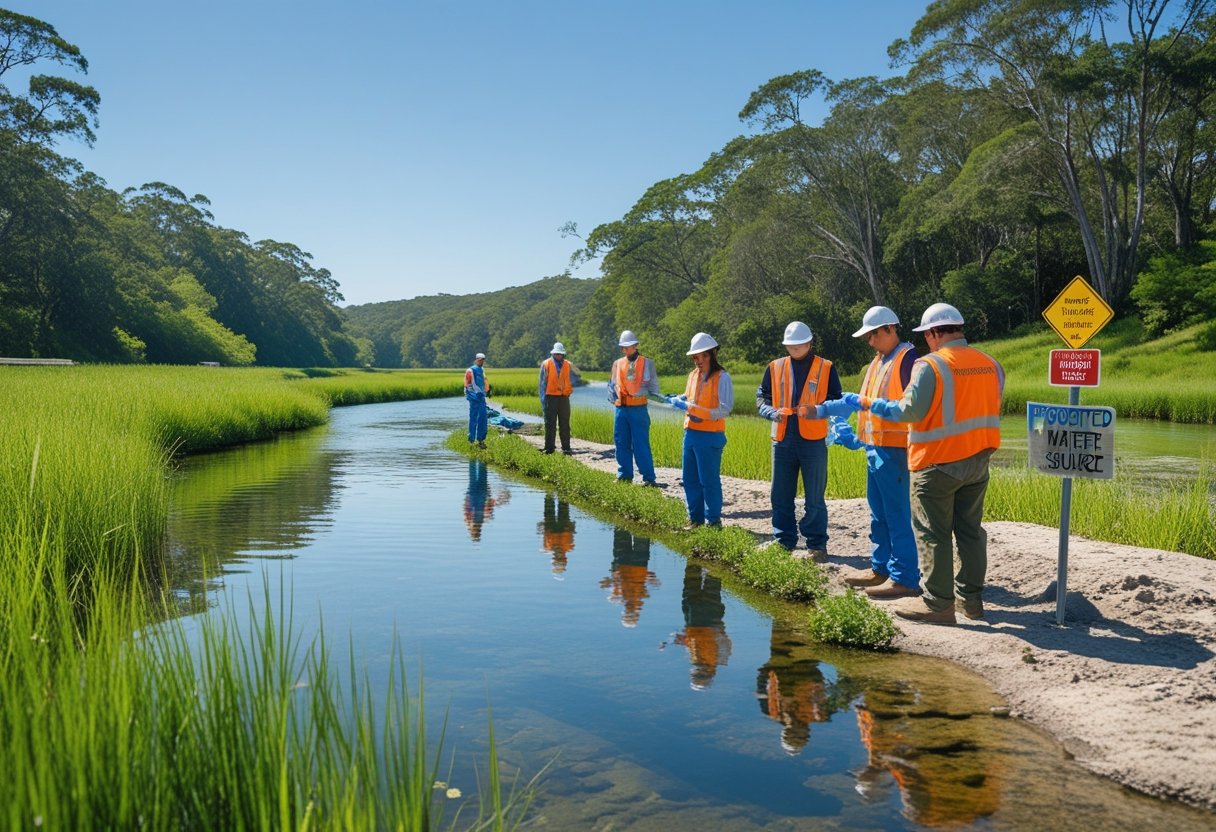When a backflow preventer fails, you’ve got to move fast if you want to keep your water safe and your property out of trouble. A quick response keeps dirty or contaminated water from sneaking back into your clean supply—and that’s not just gross, it’s dangerous. If you wait, you’re basically inviting expensive repairs and water headaches nobody wants.
You want help that shows up right away and knows what they’re doing. In San Diego County, Pacific Backflow is on call for emergencies, so you’re not left hanging when things go sideways. Dealing with backflow issues right away is just smart—it keeps your home, business, and neighborhood water in the clear.
Understanding Backflow Emergencies
Backflow emergencies crop up when water reverses direction in your pipes. Suddenly, dirty or contaminated water can mix with the stuff you drink or use every day. That’s a health risk you don’t want. If you know what causes backflow, how to spot it, and where it usually happens, you’ll be ready to act fast and protect your water.
What Causes Backflow
Backflow kicks in when the pressure changes inside your plumbing. Normally, water just flows in—from the city supply straight into your house. But if the pressure drops, say, because of a water main break or a big spike in demand nearby, water can start moving backwards.
That’s when things like dirt, chemicals, or bacteria from irrigation systems, drains, or other sources can get sucked into your clean water.
Some usual culprits:
- Water main repairs or breaks
- Big water demand causing pressure dips
- Broken valves or backflow preventers
- Cross-connections where clean and dirty water meet
A good backflow preventer keeps all of that out and your water safe.
Common Signs of Backflow
You can’t always see backflow happening, but there are some telltale signs. If you spot any of these, don’t wait around:
- Weird taste or smell in your water
- Water from faucets looks discolored or cloudy
- Water pressure drops or changes suddenly
- Pipes or drains making gurgling noises
- Water fixtures acting up
These are big red flags. Your water could be contaminated, or your backflow device might’ve failed. The sooner you jump on it, the better.
Typical Locations for Backflow Issues
Backflow trouble usually pops up where clean and dirty water are close together. Here’s where you’ll want to keep an eye out:
LocationWhy It's at Risk Irrigation systemsFertilizers or chemicals can enter pipesBoilers and cooling systemsPressure changes and cross-connections occurFire sprinkler systemsWater stagnation can cause contaminationHose bibs and outdoor tapsHoses left in puddles or chemicalsIndustrial and commercial sitesComplex plumbing increases risk
Knowing these spots helps you catch problems early. Pacific Backflow covers all of San Diego County with testing and repairs, so your water stays safe wherever you are.
The Importance of Quick Response
Jumping into action during a backflow emergency keeps your water supply clean. It protects everyone who uses that water and saves you from a repair bill you really don’t want. Plus, you’ll stay in line with local water safety codes.
Preventing Contamination
When a backflow preventer gives out, dirty water can slip right back into your clean supply—especially if there’s a pressure drop or a pipe breaks.
If you don’t fix it fast, bacteria or chemicals can get into your drinking water. That stuff spreads quickly and can hit homes, businesses, and public spaces before you know it.
Stopping backflow right away is the only way to keep things safe. Emergency crews can cut off the problem and protect your water before it turns into a bigger mess.
Protecting Public Health
Backflow can expose people to germs, chemicals, or even waste. Drinking or using that water? Not a good idea—serious illnesses can follow.
A fast response means less chance of anyone getting sick. Quick repairs protect your family, staff, and the whole community.
Places like schools, hospitals, and restaurants really can’t afford to mess around. If the water isn’t reliable, everything stops. A quick fix keeps things running and everyone healthy.
Reducing Repair Costs
Letting a backflow problem drag on? That’s how leaks and contamination end up damaging pipes and equipment.
If you move quickly, you limit the damage and avoid those big repair bills. Small fixes now can keep you from facing a full-blown emergency later.
You’ll also stay out of trouble with the water district. Pacific Backflow’s technicians handle quick testing and repairs, so your system keeps working and you don’t get hit with extra charges.
Health Risks Associated With Delayed Action
Dragging your feet during a backflow emergency is risky. Contaminants can get in fast, and some people are hit harder than others. If you act quickly, you’re helping protect your health and everyone else’s, too.
Exposure to Harmful Pathogens
Backflow lets dirty water from drains or chemicals mix with your clean supply. That’s a straight shot for bacteria and germs to end up in your drinking water. Use it, and you could get sick—think stomach bugs, diarrhea, or worse.
If you wait to fix the problem, those germs stick around longer. That just ups the odds of someone getting sick. Early detection and a quick fix keep harmful stuff from spreading and keep your water safe.
Impact on Vulnerable Populations
Some folks are more at risk than others. Kids, seniors, and anyone with a weak immune system can get hit hard by waterborne illnesses from backflow.
Babies and older adults can get really sick from bacteria or viruses that wouldn’t faze a healthy person. If you’re caring for these groups, fast action isn’t just smart—it’s necessary.
Delays can cause outbreaks in places like schools or nursing homes, putting a lot of people in danger. If you’re in San Diego County, Pacific Backflow offers fast help to keep your water safe.
Property Damage From Unchecked Backflow
Ignoring backflow emergencies can wreck your property. Water flowing the wrong way through your plumbing can damage building materials and ruin your stuff, leading to expensive repairs. Act fast, and you can dodge a lot of that trouble.
Water Damage to Structures
Backflow can leak contaminated water into your walls, floors, and ceilings. That water soaks into wood, drywall, and insulation, causing rot, swelling, or even collapse. Over time, the damage just gets worse and costs more to fix.
And if moisture hangs around, mold can show up fast. Mold isn’t just gross—it can mess with your air quality. Cleaning up after backflow usually means more than just drying things out; you might need to replace parts of your building to really fix it.
Loss of Personal Belongings
Backflow water is dirty, sometimes even toxic. It can ruin furniture, electronics, clothes—you name it. Some things, once soaked, are just gone for good.
Important papers or sentimental stuff? If they get wet, you might not be able to save them. Fast action limits what you lose. Emergency crews like Pacific Backflow can shut things down quickly and start repairs to save what matters.
Steps to Take During a Backflow Emergency
If you notice weird tastes, odors, leaks, or water pressure dropping, don’t wait. Move fast—shut off your water, call in the pros, and alert the right people. These steps help keep your home or business safe when backflow hits.
Shutting Off the Water Supply
First thing—shut off your main water supply. That stops contaminated water from getting into your clean lines. Find your main shutoff valve—it’s usually near the meter or where water comes into your place.
Once it’s off, don’t use any faucets or appliances. That keeps you from spreading contamination any further. Just remember, shutting off water might affect things like fire sprinklers, so act quickly but use your best judgment.
If you can’t find the valve or aren’t sure what to do, call Pacific Backflow or a reliable plumber ASAP. The faster you stop the water, the less damage and risk you’ll face.
Contacting Certified Professionals
You need certified backflow techs to check things out and fix the problem. These folks know the codes and have the right tools to test and repair your backflow device. Call Pacific Backflow or a licensed local pro in San Diego County who handles emergencies.
Tell them what you’ve seen—leaks, odors, low pressure, whatever. They’ll test your device, fix or swap out bad parts, and make sure you’re up to code.
Don’t wait too long. Certified pros show up fast and handle the paperwork for water authority compliance, so you don’t have to stress.
Notifying Local Authorities
Let your local water agency or health department know if you spot backflow. They might need a report or inspection to keep the public water supply safe.
Give them details—when you shut off water, what happened, and if you’ve got pros on site.
Some places have strict rules about reporting contamination. Your backflow service can help with the paperwork or walk you through what’s required. Fast notification limits the impact and keeps your community safer.
Choosing the Right Emergency Backflow Service
When backflow hits, you need help—fast. Look for a company that responds quickly, has certified experts, and a reputation you can trust. That’s how you know your problem will get fixed right and your water stays safe.
Evaluating Response Times
How quickly a company gets to you can make all the difference. You want someone offering after-hours emergency support—not just 9-to-5.
Ask how fast they usually respond and when a tech could get to you. A solid company will have a plan for emergencies and let you know what to expect.
The faster they act, the less chance you have of contamination spreading. That keeps your water safe for you and your neighbors.
Checking Qualifications and Certifications
Not every plumber can handle backflow. Make sure you hire someone with special backflow certifications. That’s proof they know what they’re doing with the equipment and the rules.
Check that they’re licensed by your state or water authority. Certified techs follow the safety codes and keep you out of hot water with the law.
When trained experts do the job, you know your preventer is fixed right the first time.
Reading Reviews and Testimonials
See what others have to say before you pick a service. Online reviews or word of mouth from neighbors can tell you a lot. Look for comments about reliability, speed, and how well the work gets done.
A company with happy customers is a good sign. Notice how they handle emergencies and how easy they are to reach.
Pacific Backflow, for instance, has a solid rep in San Diego County for being fast and reliable. Reviews say they communicate clearly and get repairs done right.
Preventative Measures to Minimize Backflow Risks
You can cut down backflow risks and keep your water clean with a few smart moves. Regular checks and the right gear keep things flowing smoothly and help you avoid big emergencies.
Regular System Inspections
Inspections catch problems before they explode. Get a certified pro to test your backflow preventer at least once a year. That way, you know it’s working and you’re following local rules.
During an inspection, the tech checks for leaks, worn parts, or blockages that could let backflow happen. Catching these issues early stops contamination and saves you money. Afterward, you’ll get a report and advice if you need repairs or upgrades.
Quick, reliable inspections keep your system safe. At Pacific Backflow, certified experts handle the testing and file reports with the water authorities, so you stay in compliance.
Installing Backflow Prevention Devices
Getting the right backflow preventer in place is honestly one of those things you don’t want to skip. There are different types, and which one works best depends on your water pressure and the quirks of your plumbing.
It’s smart to have a professional help you pick and install a device that fits your local codes and your property’s setup. When installed properly, these things just last longer and do their job. You’ll want to protect the device, too—cages or covers can fend off damage or tampering.
If you’re missing a backflow preventer, or yours is ancient, it’s time to swap it out. Newer models have better tech and, truthfully, a lot of water authorities require them now. Pacific Backflow can handle compliant, quality installs so your water stays clean and your system stays out of trouble.
Legal and Regulatory Considerations
When you’re dealing with a backflow emergency, you really need to know the rules. Local and national standards aren’t just red tape—they’re there to keep your water safe and help you avoid fines. Quick action helps you stay on the right side of these laws and protects your water.
Local Ordinances and Requirements
Every city or county has its own take on backflow prevention. In San Diego County, for instance, you need annual backflow testing from certified techs. These yearly checkups make sure your devices actually work and keep contaminants out.
If your backflow preventer fails or starts leaking, most places require you to fix or replace it right away. Ignore that, and the fines can pile up. You’ll also need to keep records of any testing or repairs—water authorities can ask for them anytime.
Pacific Backflow makes compliance easier by doing certified testing and handling the paperwork with local agencies. That way, you dodge legal headaches and keep your water safe.
Compliance With National Standards
Beyond your local rules, there are national regulations you’ve got to follow. State and federal laws say backflow devices need testing at least once a year, and only certified pros should do it. That’s how we protect everyone’s drinking water.
The EPA and other agencies lay out clear standards—proper installation, regular upkeep, and quick emergency fixes if something goes wrong. Sticking to these rules isn’t just about avoiding trouble; it actually keeps contamination risks down.
Your backflow system needs to meet all codes and get prompt attention if there’s an emergency. Fast repairs help you stay legal and stop dirty water from spreading, which is just common sense if you ask me.
Frequently Asked Questions
Quick action really does stop contamination from spreading and keeps property damage to a minimum. Knowing your next move can make a big difference for your water supply and your health.
What steps should you take in case of a backflow incident?
First, turn off your main water supply to keep contaminated water from moving through your pipes. Then, call a professional backflow service like Pacific Backflow to check things out and handle repairs. Hold off on using any water until they give you the all-clear.
How can you minimize damage from a backflow emergency?
Shut off the water right away and don’t touch any faucets or appliances connected to the affected system. Get emergency backflow repair service on the line so they can restore safe water flow fast. The quicker you move, the less mess you’ll have to deal with.
What are the health risks associated with backflow events?
Backflow brings in dirty water, chemicals, and bacteria—none of which you want in your drinking water. This kind of contamination can lead to stomach bugs, infections, and other nasty health issues if you drink or use it.
Why is immediate action crucial during a backflow crisis?
Contaminated water doesn’t wait around; it can move fast through your plumbing. Jumping on the problem helps protect your health, saves you from costly repairs, and keeps your water legal and safe.
How do you identify a potential backflow problem before it becomes an emergency?
Get your system tested regularly by certified pros. Watch for weird tastes, smells, or cloudy water. Also, keep an eye out for drops in water pressure or leaks near your backflow device. Sometimes these little signs are your best warning.
What are common signs of an impending backflow issue to watch out for?
Ever heard weird gurgling in your pipes? Or maybe water’s bubbling up in the sink or tub when it shouldn’t? Sometimes the water pressure just drops out of nowhere. If you spot any of that, it’s probably time to call someone in and check things out before it turns into a bigger headache.











